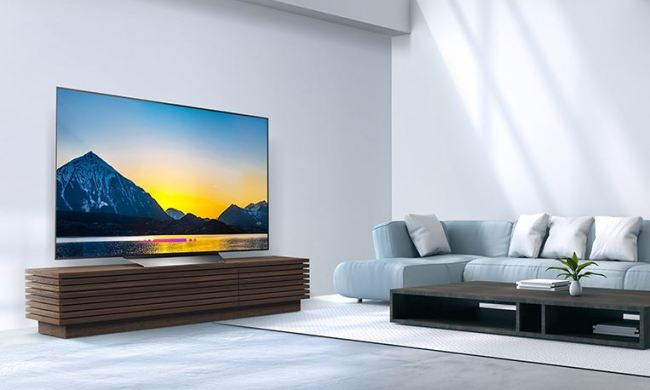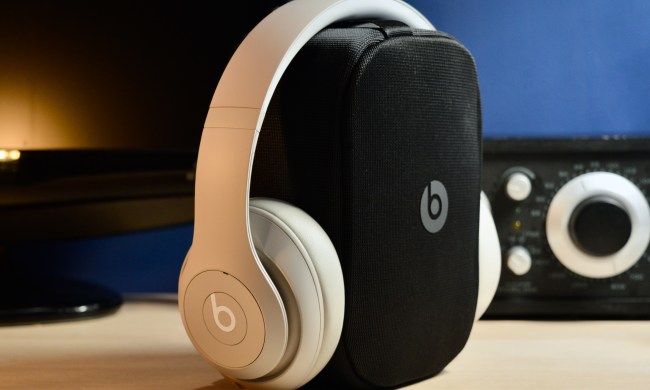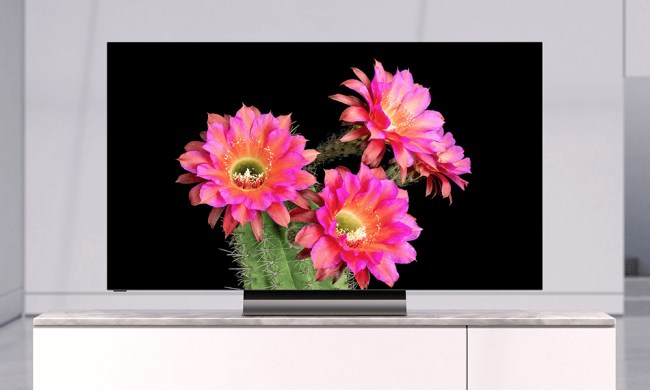“Sony has engineered a valiant attempt at the ultimate vehicle for Internet TV, but Google TV’s persistent potholes provide a bumpy ride.”
- Complete Google TV integration into every aspect of the TV
- Image quality exceeds spec expectations
- Modern edge-to-edge glass design
- Smart, capable controller
- Reasonably priced
- Google TV remains under construction
- Steep learning curve for controller
- Wobbly stand
Sony GT1 series information: Our review of Sony’s 40-inch NSX-40GT1 TV is based on our time with the 46-inch NSX-46GT1TV. The observations made here are applicable to the 32-inch NSX-32GT1. According to Sony, the Internet Connected sets have identical specifications (save dimensions and weight). Therefore, they should offer similar performances.
If every HDMI cable on earth were suddenly shredded to copper threads and you could never connect another device to your TV again, Sony’s Internet TVs would be the ones to own. Simply put, no other connected television packs this much content into one clean, self-contained unit. Though the lack of cables and all-in-one approach eases setup and use, Google TV’s rough edges will still make us warn non-geeks away from this otherwise sharp connected TV for the time being, but patient tech enthusiasts will find a bevy of content and possibilities built right in.
Features
Take an HDTV and a Google TV set-top box, smash them together, and you most likely have a broken TV and a broken set top box. (Not where you thought we were going with that, huh?) No, Sony’s Internet TV goes a level deeper than the Neanderthal mash up you might expect by painstakingly integrating every aspect of a television’s function into the

Beneath the surface, both Sony’s Internet TVs and Logitech’s Revue are powered by a 1.2GHz Intel Atom processor that’s not far off from what you might find in a netbook. The set offers both Wi-Fi and a standard Ethernet jack for Internet connectivity and network access.
On the more pedestrian side, Sony’s Internet TVs offers the usual array of Sony features including 1080p upscaling, MPEG noise reduction, media playback via USB, and Eco Settings for lower power consumption.
In an apparent concession to the system’s all-in-one, future-leaning design, Sony goes light on traditional connectivity, offering analog RCA, component video, digital optical audio and headphone outputs, but only one of each, and the component and RCA video inputs both share the same audio inputs, so you can use one or the other. Notably, there’s no VGA input for old-school notebooks. However, geeks will be happy to find four HDMI inputs (two rear, two side) and an impressive four USB inputs (all four on the side for easy access).
 Design
Design
Sony’s Internet TV is as much an appliance as television, and Sony gives that self-contained philosophy a nod in the style. It’s one of the few big-screen TVs we’ve ever seen to come in white, an eggshell shade that wouldn’t feel out of place in the kitchen. You’ll have to peek behind the edge-to-edge glass on the front to even see it, though, which has been blacked out around the edges for a play on the same “monolithic” look that appears on high-end Sonys like the NX8 series.
Then there’s that stand. For all the over-engineering put into TV stands, from Samsung’s liquid-inspired teardrops to Sony’s own glass-and-aluminum marvels, the bare metal bar that supports Sony’s
Despite the fact that it essentially houses a mini computer, Sony has kept the NSX-40GT1to just 2.25 inches deep, and there’s not a fan to be found. Top and bottom perforations in the plastic chassis seem to radiate the heat away just fine.
Setup
With no cables to connect, setting up Sony’s Internet TV is literally as simple as plugging in the power cord and turning it on. After typing in your Wi-Fi password (or connecting an
Google TV
Hardware aside, Sony’s Internet TV fundamentally works the same as Logitech’s Revue, when you get down to the 1’s and 0’s. Which is why it came as such a surprise to us that Sony, through a handful of subtle tweaks, does it much better.
To spare some digital ink, we won’t repeat our overall impressions of
First, Sony’s quintessentially Japanese controller-slash-remote. Tiny, obtuse, and covered with more buttons than ants on a spilled Coke, it’s the antithesis of everything Apple’s user interface philosophy represents. But it works well. Unlike Apple’s svelte remote, you can enter passwords and search terms in less than the time it would take to translate said text into Morse code and back again. Unlike Logitech’s supersized Revue keyboard, it fits properly in your hands and won’t take up an entire couch cushion. Unlike the near-perfect Boxee Box remote, it has an optical trackpad for fluid cursor movement. The learning curve might be steeper than any of these (just figuring out how to activate the mouse was a struggle at first) but we respect Sony for offering a powerful tool over one that’s merely easy to use.
Second, integrating
That said, many of our original gripes remain. The controller may be better, but
Access to the over-the-air tuner also highlights another issue: Why can’t
Not surprisingly, given the Atom processor it has in common with the Revue, Sony’s
 Display
Display
Slapping a feature that costs $300 in a standalone box into an already expensive TV is a good recipe for an overpriced catastrophe with no market. A lot of
Fortunately, the specs bely the reality of the situation, which is that even these ho-hum panels look great. Despite the 60Hz refresh rate, the 46GT1 actually exhibited less motion blur than we’ve seen from much-hyped 120Hz sets, and black levels were surprisingly good for an edge- LED-lit panel.
Having stepped down from the stellar Sony NX810, we were ready for image quality to take a corresponding step down, but surprisingly, the Internet TV held its own in the office. The viewing colors lacked the same eye-popping sizzle sure, but even without Sony’s Bravia Engine 3, video quality from less-than-perfect streaming sources looked smooth and detailed especially HD content from Netflix.
Selecting “standard” settings rather than “retail” during setup spares the rainbow explosion we’re used to with new TVs, delivering clean, conservative settings right out of the box that 90 percent of viewers will be thrilled with. Our only modifications were turning up the backlight to accommodate for the brightly lit room we had it in, switching on MPEG noise reduction, and engaging black corrector.
While Sony has had to build the price of
Conclusion
Sony’s Internet TV is the closest thing you can get to a 46-inch laptop in your living room, combining the flexibility of a PC with the size and picture quality of a TV. But “closest thing” doesn’t mean perfect.
Highs:
- Complete Google TV integration into every aspect of the TV
- Image quality exceeds spec expectations
- Modern edge-to-edge glass design
- Smart, capable controller
- Reasonably priced
Lows:
- Google TV remains under construction
- Steep learning curve for controller
- Wobbly stand






